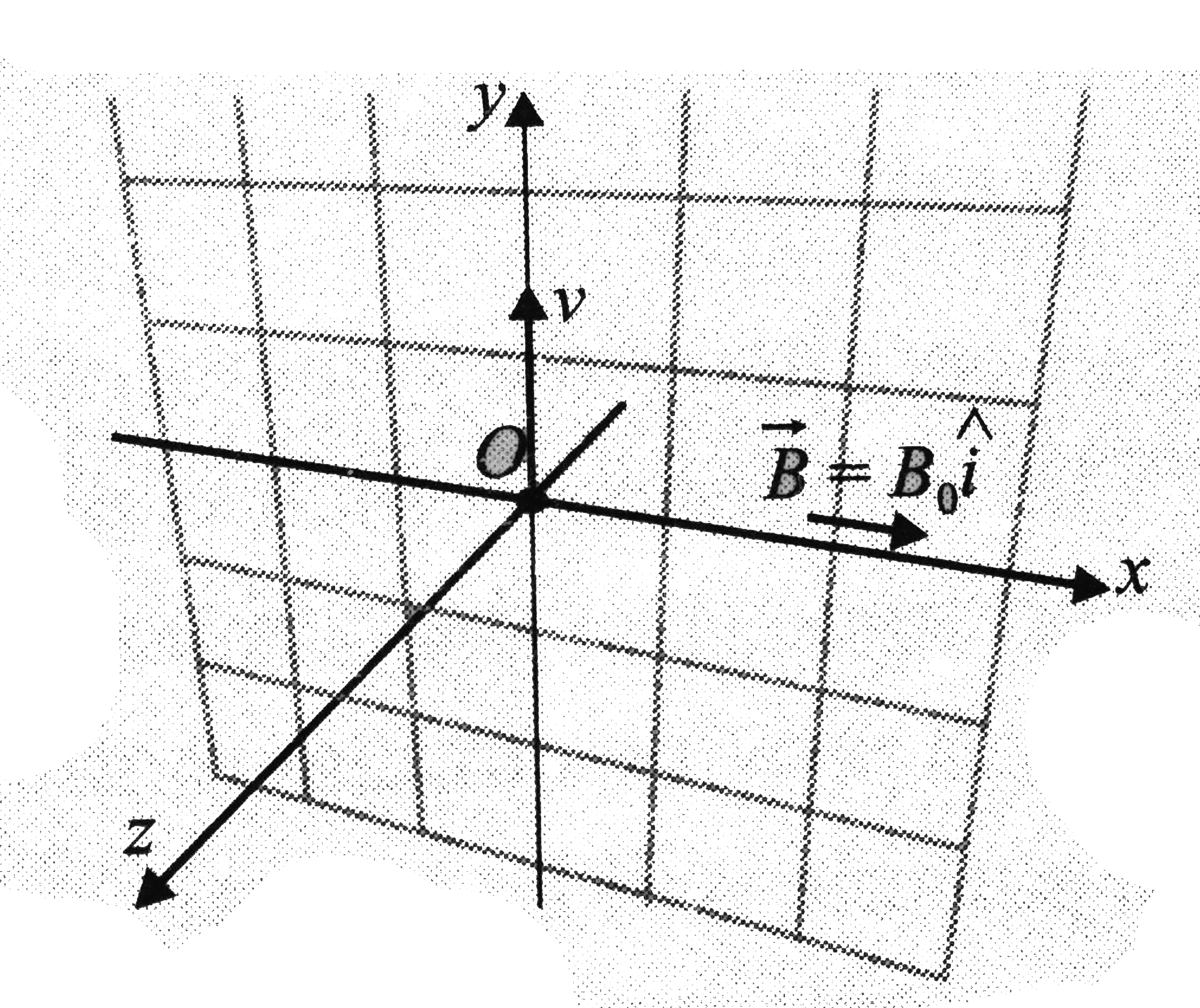A particle of mass m and charge q is moving in a region where uniform, constant electric and mangetic fields →Eand→B are present. →Eand→B are parallel to each other. At time t=0, the velocity →v0 of the particle is perpendicular to →E (Assume that its speed is always <<c, the speed of light in vacuum). Find the velocity →v of the particle at time t. You must express your answer in terms of t,q,m, the vector →v0,→E and →B and their magnitudes →v0,→E and →B.
The correct Answer is:→=→v0cos(qBtm)+qt→Em+⎡⎢ ⎢⎣(→v0×→B)Bsin(qBtm)⎤⎥ ⎥⎦
To solve the problem, we need to analyze the motion of a charged particle in the presence of both electric and magnetic fields. Given that the electric field →E and magnetic field →B are parallel, and the initial velocity →v0 of the particle is perpendicular to →E, we can follow these steps:
Step 1: Identify Forces Acting on the Particle
The particle experiences two forces:
1. Electric Force: →FE=q→E
2. Magnetic Force: →FB=q(→v×→B)
Step 2: Determine the Acceleration Due to Electric Field
The acceleration of the particle due to the electric field is given by:
→aE=→FEm=q→Em
Step 3: Calculate the Velocity in the Electric Field Direction
Since the initial velocity →v0 has no component in the direction of →E (which is along the y-axis), the velocity in the y-direction at time t can be determined using:
vy(t)=vy0+aEt=0+(qEm)t=qEmt
Step 4: Analyze the Motion in the Magnetic Field
The magnetic force acts perpendicular to the velocity of the particle. The particle will undergo circular motion in the plane perpendicular to →B. The angular frequency ω of this circular motion is given by:
ω=qBm
Step 5: Express the Velocity Components
The velocity components can be expressed as:
- In the x-direction (due to the circular motion):
vx(t)=v0xcos(ωt)=v0cos(qBmt)
- In the z-direction (due to the circular motion):
vz(t)=v0sin(qBmt)
Step 6: Combine the Velocity Components
The total velocity vector →v of the particle at time t can thus be expressed as:
→v(t)=vx(t)^i+vy(t)^j+vz(t)^k
Substituting the expressions we found:
→v(t)=v0cos(qBmt)^i+(qEmt)^j+v0sin(qBmt)^k
Final Expression
Thus, the velocity of the particle at time t is:
→v(t)=v0cos(qBmt)^i+(qEmt)^j+v0sin(qBmt)^k
The particle experiences two forces:
1. Electric Force: →FE=q→E
2. Magnetic Force: →FB=q(→v×→B)
The acceleration of the particle due to the electric field is given by:
→aE=→FEm=q→Em
Since the initial velocity →v0 has no component in the direction of →E (which is along the y-axis), the velocity in the y-direction at time t can be determined using:
vy(t)=vy0+aEt=0+(qEm)t=qEmt
The magnetic force acts perpendicular to the velocity of the particle. The particle will undergo circular motion in the plane perpendicular to →B. The angular frequency ω of this circular motion is given by:
ω=qBm
The velocity components can be expressed as:
- In the x-direction (due to the circular motion):
vx(t)=v0xcos(ωt)=v0cos(qBmt)
- In the z-direction (due to the circular motion):
vz(t)=v0sin(qBmt)
The total velocity vector →v of the particle at time t can thus be expressed as:
→v(t)=vx(t)^i+vy(t)^j+vz(t)^k
Substituting the expressions we found:
→v(t)=v0cos(qBmt)^i+(qEmt)^j+v0sin(qBmt)^k
Thus, the velocity of the particle at time t is:
→v(t)=v0cos(qBmt)^i+(qEmt)^j+v0sin(qBmt)^k
Topper's Solved these Questions
- MAGNETIC EFFECTS OF CURRENT Book:VMC MODULES ENGLISHChapter:MAGNETIC EFFECTS OF CURRENT Exercise:JEE Main (Archive)
Explore 75 Videos
- LIQUIDSBook:VMC MODULES ENGLISHChapter:LIQUIDSExercise:JEE ADVANCED (LEVEL -2)
Explore 55 Videos
- MOCK TEST 1Book:VMC MODULES ENGLISHChapter:MOCK TEST 1Exercise:PART I : PHYSICS (SECTION-2)
Explore 10 Videos
Similar Questions
An electric field (vec E) and a magnetic field (vec B)exist in a region . The fields are not perpendicular to each other.
View SolutionA charge particle of mass m and charge q is projected with velocity v along y-axis at t=0.

Find the velocity vector and position vector of the particle →v(t)and→r(t) in relation with time.
View Solution
Knowledge Check
A particle of mass m and charge q has and initial velocity →v=υ0ˆj. If an electric field →E=→–––(0)ˆi and magnetic field →B=B0ˆi act on the particle, its speed will double after a time :
At=2mv0qE0Bt=2B0qmv0Ct=√3B0qmv0Dt=√3mv0qE0
In a certain region, uniform electric field E=−E0ˆk and magnetic field B=B0ˆk are present. At time t=0, a particle of mass m and charge q is given a velocity v=vj+vk. Find the minimum speed of the particle and the time when it happens so.

View SolutionA particle of charge q and mass m starts moving from the origin under the action of an electric field →E=E0ˆiand→B=B0ˆi with a velocity →v=v0ˆj. The speed of the particle will become 2v0 after a time.
View SolutionA particle of mass m and charge q has and initial velocity →v=υ0ˆj. If an electric field →E=→–––(0)ˆi and magnetic field →B=B0ˆi act on the particle, its speed will double after a time :
View SolutionA positively charged particle is moving along the positive x-axis in a unifom electric field→E=E0ˆj and magnetic field →B=B0ˆk (where E0 and B0 are positive constants), then
View SolutionIf →a×→b×→c≠0, prove that →a+→c is parallel to →b. Hence express →a+→c in terms of →b.
View SolutionIf →c is perpendicular to both →a and →b , then prove that it is perpendicular to both →a+→b and →a -→b .
View SolutionLet →a,→b,and→c are vectors such that |→a|=3,∣∣→b∣∣=4and|→c|=5,and(→a+→b) is perpendicular to →c,(→b+→c) is perpendicular to →aand(→c+→a) is perpendicular to →b. Then find the value of ∣∣→a+→b+→c∣∣ .
View Solution